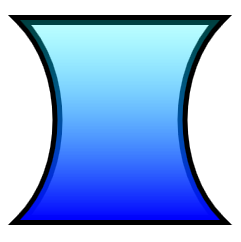Come disegnare e riempire una forma complessa
Direct2D fornisce l'interfaccia ID2D1PathGeometry per descrivere forme complesse che possono contenere curve, archi e linee. Questo argomento descrive come definire e eseguire il rendering di una geometria del percorso.
Per definire una geometria del percorso, usare prima il metodo ID2D1Factory::CreatePathGeometry per creare la geometria del percorso, quindi usare il metodo Open della geometria del percorso per recuperare un ID2D1GeometrySink. È quindi possibile aggiungere linee, curve e archi chiamando i vari metodi Add del sink.
L'esempio seguente crea un ID2D1PathGeometry, recupera un sink e lo usa per definire una forma di clessidra.
ID2D1GeometrySink *pSink = NULL;
// Create a path geometry.
if (SUCCEEDED(hr))
{
hr = m_pD2DFactory->CreatePathGeometry(&m_pPathGeometry);
if (SUCCEEDED(hr))
{
// Write to the path geometry using the geometry sink.
hr = m_pPathGeometry->Open(&pSink);
if (SUCCEEDED(hr))
{
pSink->BeginFigure(
D2D1::Point2F(0, 0),
D2D1_FIGURE_BEGIN_FILLED
);
pSink->AddLine(D2D1::Point2F(200, 0));
pSink->AddBezier(
D2D1::BezierSegment(
D2D1::Point2F(150, 50),
D2D1::Point2F(150, 150),
D2D1::Point2F(200, 200))
);
pSink->AddLine(D2D1::Point2F(0, 200));
pSink->AddBezier(
D2D1::BezierSegment(
D2D1::Point2F(50, 150),
D2D1::Point2F(50, 50),
D2D1::Point2F(0, 0))
);
pSink->EndFigure(D2D1_FIGURE_END_CLOSED);
hr = pSink->Close();
}
SafeRelease(&pSink);
}
}
Si noti che un ID2D1PathGeometry è una risorsa indipendente dal dispositivo e può quindi essere creata una volta e mantenuta per la vita dell'applicazione. Per altre informazioni sui diversi tipi di risorse, vedere Panoramica delle risorse.
L'esempio successivo crea due pennelli che verranno usati per disegnare la struttura e il riempimento della geometria del percorso.
if (SUCCEEDED(hr))
{
// Create a black brush.
hr = m_pRenderTarget->CreateSolidColorBrush(
D2D1::ColorF(D2D1::ColorF::Black),
&m_pBlackBrush
);
}
if (SUCCEEDED(hr))
{
// Create a linear gradient.
static const D2D1_GRADIENT_STOP stops[] =
{
{ 0.f, { 0.f, 1.f, 1.f, 0.25f } },
{ 1.f, { 0.f, 0.f, 1.f, 1.f } },
};
hr = m_pRenderTarget->CreateGradientStopCollection(
stops,
ARRAYSIZE(stops),
&pGradientStops
);
if (SUCCEEDED(hr))
{
hr = m_pRenderTarget->CreateLinearGradientBrush(
D2D1::LinearGradientBrushProperties(
D2D1::Point2F(100, 0),
D2D1::Point2F(100, 200)),
D2D1::BrushProperties(),
pGradientStops,
&m_pLGBrush
);
}
SafeRelease(&pGradientStops);
}
L'esempio finale usa i metodi DrawGeometry e FillGeometry per disegnare la struttura e l'interno della geometria. In questo esempio viene generato l'output illustrato nella figura seguente.

void DemoApp::RenderGeometryExample()
{
// Translate subsequent drawings by 20 device-independent pixels.
m_pRenderTarget->SetTransform(
D2D1::Matrix3x2F::Translation(20.f, 20.f)
);
// Draw the hour glass geometry at the upper left corner of the client area.
m_pRenderTarget->DrawGeometry(m_pPathGeometry, m_pBlackBrush, 10.f);
m_pRenderTarget->FillGeometry(m_pPathGeometry, m_pLGBrush);
}
Il codice è stato omesso da questo esempio. Per altre informazioni sulle geometrie, vedere Panoramica delle geometrie.